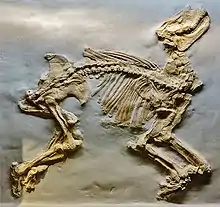Scarrittia
Scarrittia is an extinct genus of hoofed mammal of the family Leontiniidae, native to South America during the Late Oligocene epoch (Deseadan in the SALMA classification).
| Scarrittia | |
|---|---|
 | |
| S. canquelensis fossil | |
| Scientific classification | |
| Kingdom: | |
| Phylum: | |
| Class: | |
| Order: | |
| Suborder: | |
| Family: | |
| Genus: | †Scarrittia Simpson 1934 |
| Binomial name | |
| †Scarrittia canquelensis Simpson 1934 | |
| Species | |
| |
Description

Scarrittia was about 2 metres (6.6 ft) in body length, and resembled a rhinoceros with a relatively long body and neck. It had three hoofed toes on each foot, and a very short tail. Due to a fused tibia and fibula, Scarrittia would have been unable to turn its legs sideways. The short skull had 44 poorly specialized teeth.[1]
Natural history
This was a very successful genus with various known species, such as Scarrittia robusta, S. barranquensis and S. canquelensis, which lived around 30 million years ago. They lived in moist forest, near the coast, in wetlands, lakes, swamps, etc. and they ate soft vegetation, grasses, fruits and trees. Some species were omnivorous, eating also eggs and small mammals. They were not adapted for running, though their large size meant they had few enemies.
Distribution
Fossils of Scarrittia have been found in:[2]
References
- Palmer, D., ed. (1999). The Marshall Illustrated Encyclopedia of Dinosaurs and Prehistoric Animals. London: Marshall Editions. p. 252. ISBN 1-84028-152-9.
- Scarrittia at Fossilworks.org